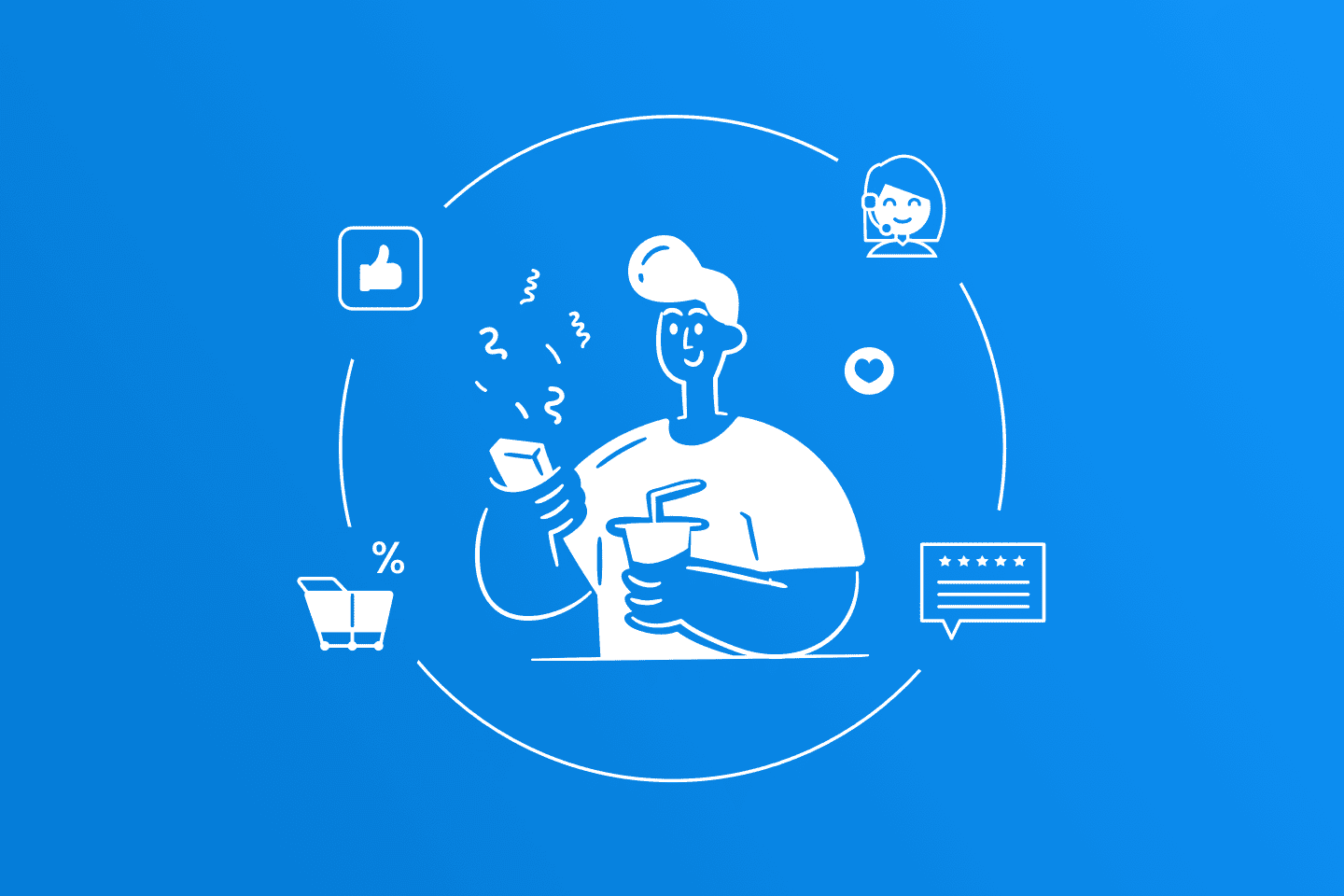True or false: Customer touchpoints impact your bottom line.
In this article, we’ll discuss why customer touchpoints are essential in a customer journey and how they can help you understand your customers’ needs better.
Zendesk research states that 54% of customers want to buy from companies that prioritize diversity, equity, and inclusion in their communities and workplaces.
This means that how you interact with customers impacts your brand reputation and bottom line. This includes the quality of your customer support.
Providing as many customer support channels as you can isn’t enough.
First, you need to identify each customer touchpoint. Then, you need to improve each and every interaction with existing and potential customers on each of those touchpoints. Why? Because it will help you understand their needs and pain points better and you’ll be able to provide a suitable product or service.
What Is A Customer Touchpoint?
A customer touchpoint is any interaction between a customer and your brand. This can be via your sales department, customer support agents, and even digital media platforms before, during, and after they have purchased from your business.
So your customer journey basically consists of a set of touchpoints. Your customers travel through those touchpoints that lead them to purchase. Then they travel along more touchpoints as they are nurtured for repeat purchases and eventually brand loyalty.
Thanks to digital transformation, there are various options for interaction channels and customer touchpoints. However, this also makes it more difficult. After all, you might forget a touchpoint. Or you might be absent in a potential major platform. If you neglect crucial touchpoints, you might end up losing your customers, their loyalty, and your potential income at the end of the day.
The Emergence Of Digital Customer Touchpoints
Let me throw more statistics at you: if companies use ten channels, 6 of them would be digital channels.
Yep, digital customer touchpoints have prevailed even before the pandemic and more so in this after-pandemic era. To be fair, some industries like retail might also benefit from offline channels, but those are slowly losing their relevance.
Here’s a list of the most common examples of digital touchpoints:
- Finding or discovering your eCommerce store via your website, targeted ads, or remarketing efforts.
- Interacting with your app
- Scrolling through review platforms and finding your product or brand
- Passing by or actually visiting your physical store (relevant for retailers)
- Contacting your customer support channels
Here’s the truth. Your website and email campaigns are not enough to ensure that your customers will continuously engage with your brand.
That’s why you should expand your reach and use multiple channels to communicate directly with your customers. There’s SMS, social media, and online communities. Virtual Reality (VR) and Augmented Reality (AR) apps as well as IoT-enabled devices are also starting to gain popularity as customer touchpoints.
So what should you do? Should you just “spray and pray” and be present everywhere?
No. Not really.
You need to figure out what channels perform the best for your brand. Then you can optimize from there and work out some tactics to boost the quality of your interaction with customers on those channels at different stages of their customer journey.
How Many Types Of Digital Customer Touchpoints Are There?
There are five customer journey stages: awareness, engagement, evaluation, purchase, and post-purchase. Customer touchpoints can have multiple variations along each stage.
Let’s check out these touchpoints:
Awareness Stage Digital Touchpoints
Website
One of the primary digital touchpoints is your eCommerce website. Many potential buyers can find your company online. They get interested and they start to explore the products or services you offer. If you play your cards right—rather, if your website is conversion-optimized, you’ll be able to pull in sustainable revenue.
Be sure to pay attention to the information you provide and how you present the info on your website. It should be clear and concise. Otherwise, you will lose potential customers.
Social media
Your social media channels play important roles in the awareness stage.
Don’t skimp on posting images and promoting your products or blog posts. Look into running brand awareness ads to put your products in front of online users who are most likely to buy.
Here are some social media touchpoints you should look into:
- Company page or account
This page performs the same role as your website homepage. Your potential customers can learn more about your brand and what you offer.
- Company activities and messages
Social posts are great for sharing your brand story. Do not underestimate it and work out a strategy for managing your online presence on these platforms. Also, be sure to engage your customers to leave comments and reshare your posts. You can also repurpose any user-generated content you come across.
- Chatbots
Online shoppers want answers to their questions right away. Of course, the quality of chatbot answers depends on how it can learn and evolve, but a quick response to a general question is better than no answer at all.
Engagement Stage Digital Touchpoints
Contact sales reps
Now that your potential customers are aware of your company, it’s time to engage them and pull them further down the funnel. The easiest way to do this is to involve and get your sales representatives. At this stage, the interaction can happen via phone, VoIP calls, or live chat with a human, not a bot.
Product catalogue
Online catalogs give online users visualization of your product or service. This includes actual use cases, samples, and customer feedback. This is an excellent way to showcase your product and bring it front and center. Don’t forget to add CTAs and QR-codes to make getting in touch with you easier.
Evaluation Stage Digital Touchpoints
Educational content to nurture your leads
While educational content helps during the awareness stage, it also contributes during the evaluation stage.
Optimize your blogs and other educational content so they can be easily found online. This is another way to convince your potential customers to choose you. Try to think from the point of view of your target consumers. What do they need and what are they looking for?
If you’re able to provide value, your business will surely stand out.
Product reviews
Feedback and reviews play a significant role in the consumer decision-making process. It is also connected to the awareness stage.
Before contacting a vendor or brand, people usually go online to check reviews and ratings.
To make sure that you are well-equipped during this touchpoint, start investing in your customer review library. Start asking your existing customers but don’t be pushy.
There are some horror stories about how demanding some companies, sole entrepreneurs, or freelancers can be when it comes to asking for feedback.
Purchase Stage Digital Touchpoints
This stage is of utmost importance. How you deliver the product or service can make or break the customer experience.
Be sure to meet all conditions and work schedules you stated in your SLAs and product or service descriptions. The expertise and knowledge of your support and accounting managers should be top-notch. It’s important to take the time to train your team and set up your ticket management, supply chain, and logistics.
Post-purchase Stage Digital Touchpoints
Follow-ups
The purchase stage isn’t the ending. In fact, it can be the start of recurring revenue and repeat purchases. How can you motivate your customers to purchase again? Enroll them in a follow-up or nurture program where you can keep their interest high. Consider offering them a discount on their next purchase, or explore other incentives like free shipping or reward points.
Newsletter
Another option is to get customers’ agreement to send them marketing emails—like a weekly newsletter with insights or valuable tips. That way, apart from updating customers on the industry news and trends, you can showcase your seasonal or special offers.
The Importance Of A Customer Journey Map
It’s necessary to create a customer journey map so you can monitor all your customer touchpoints.
A customer journey map is a visual overview of all the experiences your customers face when they interact with your company. It starts with the customer’s need for a specific product or service, then the encounters with your company, and ends with building customer loyalty. The customer journey map helps businesses understand what the customers go through before choosing the brand.
Knowing your touchpoints is only halfway to success. Your main aim is to increase customer lifetime value by ensuring that each touchpoint provides a seamless experience and that the whole customer journey is pleasant and personalized.
How To Measure The Effectivity Of Your Customer Touchpoints
Here are some techniques and tools that might come in handy when measuring the effectiveness of your customer touchpoints.
Look into customer feedback on social media
Listen to what your customers are saying on social media. Do note that customers usually share their thoughts when they have a negative experience or a super great one. It’s best to be ready in case there are reviews that need responses.
Analyze your data
Take a deep dive into the data you collected following your privacy and cookies policies. For instance, you can review the call center logs and study the queries. That way, you can identify and improve the weak spots in your service or product qualities.
Use tracking tools
You can use certain analytical and tracking apps to measure the effectiveness of your ads. For example, if you prefer pay-per-click ads, you can easily track the number of users purchased after clicking your ad. If you want to measure email revenue, your email marketing software should have dashboards that will reflect the placed orders from each email.
Define what you want to track, and look for a corresponding tool. Data-driven decisions will give you a clearer direction on what to do next.
What Exactly Do Customers Expect From Touchpoints?
Customers of today prefer highly relevant content delivered via the devices they choose. In short, the more personalized the customer experience is, the more relevant it is.
Do keep in mind that touchpoints must be:
- Appropriate: the context of the interaction with a customer and the cultural tone should fit the customer’s needs.
- Meaningful: a customer must treat and perceive the interaction as necessary and not intrusive
- Relevant: the interaction should meet the customer’s needs.
- Endearing: the interaction should connect or bond with a customer.
Can You Control The Effect Of Digital Touchpoints?
Managing touchpoints is more complex than you think. The truth is, you can’t control each and every interaction with your customers, especially when it comes to public feedback or reviews.
However, this doesn’t mean you can’t change them. How? Online reputation tracking tools can help you track and respond to negative comments online. A fast and well-thought-out response can be a chance to improve customer experience and avoid harming your brand reputation.
Customer Touchpoints In A Nutshell
Let’s go back to the question at the start of the article.
True or false: Customer touchpoints impact your bottom line.
Answer: 100% true.
It is essential to put a lot of thought into your digital touchpoint strategy. Delighting your potential and existing customers throughout the whole customer journey can have a positive impact on your revenue and bottom line.
Now that you have an overview of how customer touchpoints can potentially affect your bottom line, you’ll be able to proceed with creating or optimizing your customer journey map.
Soon, your customer experience strategy will be like a well-oiled machine that consistently pulls in sustainable revenue for your eCommerce business.






